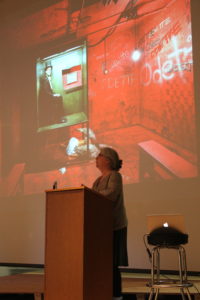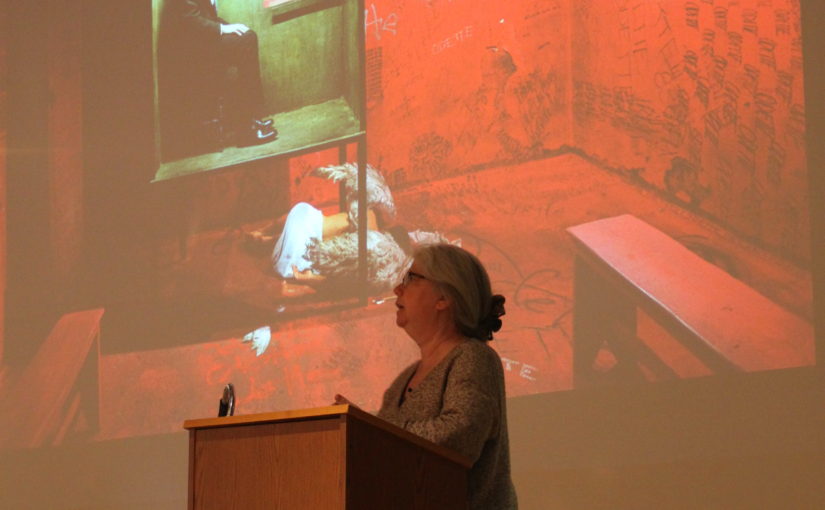
Playwright and director Mary Zimmerman discussed the three biggest component of adaptation (narrative voice, structure and pace and image) in her talk on Tuesday, March 21.
On Tuesday, several artists from around the Fargo-Moorhead area gathered in Askanase Hall to gain wisdom from Tony Award-winning director and playwright Mary Zimmerman.
Zimmerman classifies herself as an “adapter.” She told the group she primarily works on adapting non-dramatic text (novels, poems, short stories, etc.) to the stage and probing out the “embedded theatricality” from within.
Zimmerman is fascinated by the challenge of staging the “unstageable,” such as “The Odyssey,” which will be performed at NDSU April 27-29 and May 3-6, and “Metamorphoses,” which will be performed at MSUM April 5-8.
Zimmerman talked a bit about the role of the audience in a theater, emphasizing the importance of an audience’s agreement with the artists to “buy into something that is blatantly not what it is … When the audience understands something it creates an intimacy with the artists and defeats loneliness.”
From there, she took time to delve into the art of adaptation and explain the three biggest components of it.
The first is narrative voice. Zimmerman explained the narrative from a source material needs to earn its keep in the staged version and stage images must exist in a harmonic balance with the text. In other words, she strives to think of basic language as music.
The second component is structure and pace of the show. Zimmerman explained it is easier and more effective to condense an epic work like “Arabian Nights” than it would be to dilute and lengthen a short story. She compares print to a clear window, explaining how a script (if it were printed how it were to be read) should have multiple fonts and font sizes throughout.
She believes the actor takes a bit of an author role in theater, because it is crucial for them to actually tell the playwright’s story.
The final component is image. Zimmerman explained theater, at its core, is a metaphor. The job of the director and author is to create the images for the theater to live in.
“Theater exists between the physical world of the stage and the imaginative interpretation of the images by the audience,” Zimmerman said.
These aspects of adaptation ring very true in all areas of theater. An artist must have core images in their mind of what the world of the play is, but at the end of the day, the only thing that matters is what the audience took away from it.
Artists can put all the effort in the world into creating images to convey a message or feeling to the audience, but if the audience has chosen from the get-go to not suspend their disbelief, they have left a curtain closed for the entire performance.
NDSU, MSUM and Concordia College are all participating in the Mary Zimmerman Festival, an exploration and celebration of Zimmerman’s works.
MSUM kicks off the festival with their staging of Zimmerman’s play, “Metamorphoses,” from April 5 – 8. Concordia follows with “The Secret in the Wings” from March 30 – April 2. Finally, Theatre NDSU will host “The Odyssey” April 27-29 and May 3-6 in Askanase Hall.
For information or to purchase tickets, visit:
For MSUM: tickets.mnstate.edu or call (218) 477-2271.
For Concordia: Call (218) 299-3314
For NDSU: tickets.ndsu.nodak.edu or call (701) 231-7969
